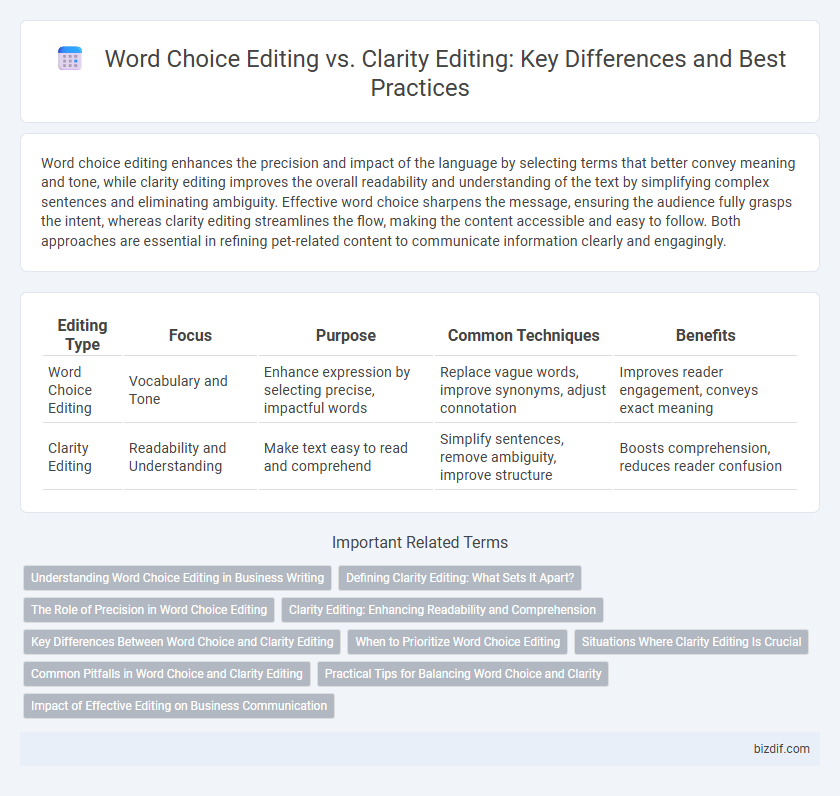Word choice editing enhances the precision and impact of the language by selecting terms that better convey meaning and tone, while clarity editing improves the overall readability and understanding of the text by simplifying complex sentences and eliminating ambiguity. Effective word choice sharpens the message, ensuring the audience fully grasps the intent, whereas clarity editing streamlines the flow, making the content accessible and easy to follow. Both approaches are essential in refining pet-related content to communicate information clearly and engagingly.
Table of Comparison
| Editing Type | Focus | Purpose | Common Techniques | Benefits |
|---|---|---|---|---|
| Word Choice Editing | Vocabulary and Tone | Enhance expression by selecting precise, impactful words | Replace vague words, improve synonyms, adjust connotation | Improves reader engagement, conveys exact meaning |
| Clarity Editing | Readability and Understanding | Make text easy to read and comprehend | Simplify sentences, remove ambiguity, improve structure | Boosts comprehension, reduces reader confusion |
Understanding Word Choice Editing in Business Writing
Word choice editing in business writing focuses on selecting precise, impactful vocabulary that aligns with the brand's tone and effectively conveys the intended message. This process eliminates ambiguity by replacing vague or overly complex terms with clear, audience-appropriate language, enhancing comprehension and engagement. Unlike clarity editing, which addresses overall sentence structure and flow, word choice editing hones in on the exact words that drive persuasive and professional communication.
Defining Clarity Editing: What Sets It Apart?
Clarity editing enhances the overall understanding of a text by focusing on simplifying complex sentences, improving flow, and ensuring logical coherence. Unlike word choice editing, which centers on selecting precise vocabulary for style and tone, clarity editing prioritizes making ideas easily accessible and reducing ambiguity. This process often involves rephrasing awkward structures and eliminating redundant information to facilitate reader comprehension.
The Role of Precision in Word Choice Editing
The role of precision in word choice editing lies in selecting terms that convey exact meaning, eliminating ambiguity and enhancing the text's impact. Word choice editing focuses on appropriateness and nuance, ensuring vocabulary aligns with the intended tone and audience, whereas clarity editing emphasizes logical flow and ease of understanding. Precise word selection sharpens communication by refining diction and avoiding vague or unnecessary words, ultimately strengthening the writer's message.
Clarity Editing: Enhancing Readability and Comprehension
Clarity editing enhances readability and comprehension by refining sentence structure, eliminating ambiguity, and ensuring logical flow in the text. Unlike word choice editing, which focuses on selecting precise vocabulary, clarity editing prioritizes the overall coherence and ease of understanding for the reader. Effective clarity editing results in a polished, accessible document that effectively communicates the intended message.
Key Differences Between Word Choice and Clarity Editing
Word Choice Editing focuses on selecting precise, impactful vocabulary to enhance the text's tone and meaning, emphasizing synonyms, diction, and word connotation. Clarity Editing aims to improve overall understanding by restructuring sentences, eliminating ambiguity, and ensuring logical flow for reader comprehension. The key difference lies in Word Choice Editing optimizing individual words, while Clarity Editing addresses sentence-level coherence and readability.
When to Prioritize Word Choice Editing
Prioritize Word Choice Editing when the precision and impact of vocabulary directly influence the tone, style, or persuasive power of the text, such as in marketing copy, creative writing, or nuanced academic arguments. This form of editing refines word selection to enhance emotional resonance and specificity, ensuring the language aligns closely with the intended audience and purpose. Clarity Editing becomes more relevant when the primary goal is to simplify complex ideas or improve overall readability without altering the original voice or stylistic nuances.
Situations Where Clarity Editing Is Crucial
Clarity editing is crucial in legal documents, medical reports, and technical manuals where precise understanding effects safety and compliance. Unlike word choice editing that enhances style and tone, clarity editing eliminates ambiguity and ensures the message is straightforward. In high-stakes environments, clear communication prevents costly misunderstandings and legal disputes.
Common Pitfalls in Word Choice and Clarity Editing
Common pitfalls in word choice editing include overuse of jargon and imprecise vocabulary that confuse readers and dilute the message. Clarity editing often struggles with ambiguous sentence structure and lack of concrete examples, leading to misinterpretation or reader disengagement. Both require careful attention to audience understanding and context to enhance communication effectiveness.
Practical Tips for Balancing Word Choice and Clarity
Effective editing balances precise word choice with clear expression, ensuring each term enhances understanding without overwhelming the reader. Prioritize replacing jargon and ambiguous words with straightforward alternatives while maintaining the text's tone and intent. Employ iterative revisions to refine vocabulary and sentence structure, achieving optimal clarity and reader engagement.
Impact of Effective Editing on Business Communication
Effective word choice editing sharpens message precision by selecting terms that resonate with the target audience, enhancing engagement and comprehension. Clarity editing restructures sentences and eliminates ambiguity, ensuring the communication is straightforward and easily understood. Together, these editing strategies elevate business communication, fostering stronger client relationships and promoting professional credibility.
Word Choice Editing vs Clarity Editing Infographic

 bizdif.com
bizdif.com